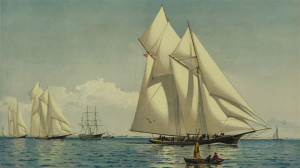In the interminable run-up to the 2013 America’s Cup on San Francisco Bay, in which a quartet of 72-foot-long billboards disguised as catamarans will navigate a couple of sausage-shaped loops between the Golden Gate Bridge and the east side of Alcatraz, much hype has been hurled at the design of the sail, which is knowingly referred to as a wing. Indeed, it is a selling point of this marvel of technology and lucre that the officially sanctioned AC72, as the craft’s class is called, can fly, allowing it to achieve top speeds of 50 miles per hour.
A new exhibition at the SFO Museum, America’s Cup: Sailing for International Sport’s Greatest Trophy 1851–1937, through February 2014, is devoted to a time when sailors actually spent a lot of time thinking about the performance of their schooners and sloops below the waterline. Unlike the AC72s, which weigh less than 7 tons and whose carbon-composite hulls have a maximum draft of 14 feet when they aren’t hydrofoiling, the wooden hull of America, the winning yacht in the first America’s Cup race around England’s Isle of Wight, spent most of the course’s 53 nautical miles under water, thanks to the schooner’s overall weight of 170 tons.

Judge magazine cover, 1903. Collection: Herreshoff Marine Museum/America’s Cup Hall of Fame
Located in the pre-security area of the airport’s International Terminal, between the Inmotion and SFMOMA stores, the SFO Museum exhibit fills two large display cases and a third smaller one with relics of the early America’s Cup era. Organized chronologically from left to right, the cases contain reproductions of paintings and photographs of the defending and challenging yachts, as well as essays about, and artifacts from, each race. Among other things, we learn that the America’s Cup was always the pastime of the super-rich (no surprise there), that changes in the classes and characteristics of yachts allowed to compete in the Cup have been common and that in 1876, a 25-foot catamaran trounced the big boys in a pre-Cup regatta (the Cup’s holder, the New York Yacht Club, promptly prohibited the cheeky craft from racing in the upcoming competition).

Patent model for Nat Herreshoff’s catamaran, April 10, 1877. Collection: Herreshoff Marine Museum/America’s Cup Hall of Fame.
The designer of that catamaran, Nat Herreshoff, would get the last laugh, though, designing five yachts that would win six America’s Cups between 1893 and 1920. He helmed his sloop the Vigilant in 1893, and in 1899 and 1901 his Columbia bested tea magnate Sir Thomas Lipton’s Shamrock and Shamrock II two challenges in a row. In fact, Herreshoff yachts would defeat Lipton two more times after that, in 1903 and 1920, as Lipton went on to become the Cup’s best-loved loser.




